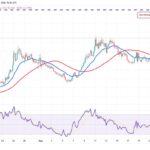In the ever-evolving world of cryptocurrencies, global economic tensions and trade disputes are creating a ripple effect felt across digital asset markets. Amid this uncertainty, Ethereum (ETH) has emerged as a resilient player, currently navigating crucial price levels between $2,500 and $2,530 that analysts identify as key resistance points for potential growth.
The backdrop of institutional interest is particularly noteworthy, as evidenced by spot Ethereum exchange-traded funds (ETFs) experiencing consistent positive inflows. This engagement from larger investors indicates a growing confidence in ETH, even as volatility defines the broader market landscape.
Recent trading activity paints a vivid picture of how the market is reacting. Over a 24-hour period, ETH demonstrated remarkable volatility with a price range of about $99.85. A sharp sell-off overnight brought the price down to $2,477.40, establishing a significant support zone that buyers quickly supported.
With trading volumes reaching 291,395 units—nearly three times the average—this support level’s importance is underscored. Following this dip, strong buying activity was observed within the $2,467 to $2,480 range, confirming a robust interest during early morning trading.
As the price climbed back to $2,515, there are indicators of bullish momentum and a potential upward trend. Analysts note that the presence of a higher low pattern raises hopes that the market correction may have found its footing. However, the immediate challenge remains: overcoming the crucial price barrier between $2,520 and $2,530 for any sustained upward movement.
The day wasn’t without its dramatic turns; a notable surge around 13:35 saw ETH jump from $2,515.85 to $2,521.79. Yet, this was swiftly followed by a reversal that dropped the price to $2,508.02, highlighting the current market indecision fueled by external influences.
As ETH continues its journey, the ongoing economic landscape will play a significant role in shaping investor sentiment and future performance. For now, all eyes remain on this pivotal price zone and the broader implications it may have on Ethereum’s trajectory.

Impact of Global Economic Tensions on Cryptocurrency Markets
Understanding the current dynamics of the cryptocurrency market, particularly Ethereum (ETH), is crucial for investors and enthusiasts alike. Here are some key points regarding ETH’s performance amidst global economic tensions and trade disputes:
- Global Economic Influence
- Economic tensions and trade disputes are affecting cryptocurrency markets.
- ETH is showing resilience, indicating investor confidence despite market uncertainty.
- Technical Performance
- ETH is navigating a critical technical zone between $2,500-$2,530 which is identified as immediate resistance.
- Overcoming this resistance is essential for continued upward movement.
- Recent price action indicates a 3.5% range, and significant trading volume supports the price at $2,467-$2,480.
- Institutional Interest
- Strong institutional interest remains evident, with spot Ethereum ETFs recording positive inflows.
- This trend suggests a growing confidence from larger investors amid market volatility.
- Market Dynamics
- ETH has displayed bullish momentum, reclaiming levels above $2,515.
- Price fluctuations show market indecision with notable daily ranges of approximately $14.46.
“Ethereum Holds Above Key Prices – Data Points To $2,900 Level As Bullish Trigger”, NewsBTC
“Ethereum Forms Inverse H&S – Bulls Eye Breakout Above $2,700 Level”, Bitcoinist
“Ethereum Price Analysis: Is ETH Primed for a ‘Healthy’ Correction?”, CryptoPotato
Ethereum Resilience Amid Global Economic Tensions: A Comparative Analysis
The turbulence in the global economy, driven by trade disputes and geopolitical uncertainties, has left its mark on various financial markets, including cryptocurrencies. However, Ethereum (ETH) appears to be weathering this storm impressively, showing a level of resilience that may set it apart from its competitors in the crypto space. While the broader market remains shaky, ETH’s ability to hold above critical price levels and garner institutional interest signifies its potential as a robust investment. This positioning not only highlights Ethereum’s strengths but also underscores the challenges it faces amidst profound market volatility.
When comparing Ethereum’s current performance to that of Bitcoin and altcoins, a distinct advantage emerges: the support from institutional investors. The recent uptick in spot Ethereum ETFs indicates a growing embrace of ETH by larger players who see promise in its fundamentals. In contrast, Bitcoin’s recent fluctuations reveal a more pronounced vulnerability to market shocks. While Bitcoin grapples with its scaling issues and regulatory scrutiny, Ethereum seems more agile, adapting to investor needs with its ongoing upgrades and enhancements.
However, this isn’t to say Ethereum is without its disadvantages. The critical resistance zone between $2,520 and $2,530 poses a significant hurdle for upward momentum. Should ETH fail to break through this barrier, it risks declining further, which could frighten retail investors. The recent sharp price volatility, including a sell-off that brought ETH down to $2,477.40, could deter potential investors already wary of the market’s unpredictable nature.
This landscape serves different groups in the investment community uniquely. Institutional investors may find ETH particularly appealing, solidifying their positions as the cryptocurrency shows signs of bullish momentum despite market pressers. This enthusiasm could lead to longer-term investments, benefiting patient capital that seeks assets with enduring potential. On the flip side, retail investors, especially those with a lower risk tolerance, might become hesitant given the evident market indecision. The rapid price swings can amplify fear and uncertainty, potentially pushing them away from engaging with Ethereum during this critical phase.
Moreover, with the market fixated on technical analysis, traders who thrive on short-term gains could see both opportunities and risks in ETH’s price movements. The current trading range may provide entry and exit points for acutely aware traders, but without concrete progress past the resistance levels, there’s an ongoing threat of further corrections pulling the price down.
Overall, Ethereum’s journey through the current economic quagmire underscores its competitive advantages, particularly its strong institutional backing and technical momentum. Yet, the challenges it must navigate are equally significant, highlighting a delicate balance for investors to consider as they explore their positions in this dynamic digital asset landscape.

















